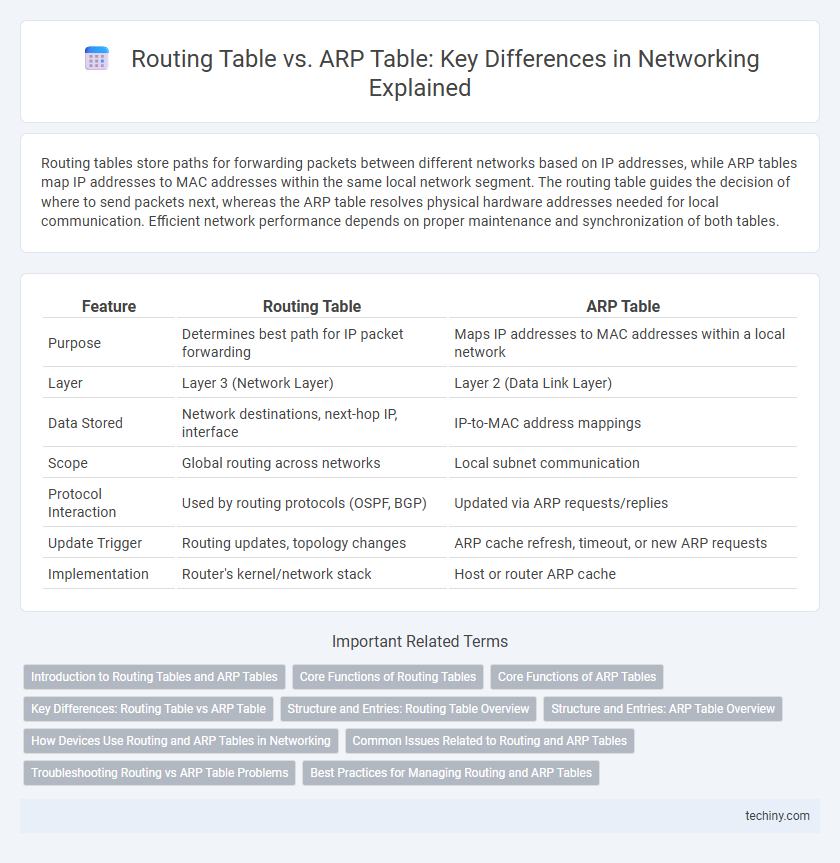Routing tables store paths for forwarding packets between different networks based on IP addresses, while ARP tables map IP addresses to MAC addresses within the same local network segment. The routing table guides the decision of where to send packets next, whereas the ARP table resolves physical hardware addresses needed for local communication. Efficient network performance depends on proper maintenance and synchronization of both tables.
Table of Comparison
| Feature | Routing Table | ARP Table |
|---|---|---|
| Purpose | Determines best path for IP packet forwarding | Maps IP addresses to MAC addresses within a local network |
| Layer | Layer 3 (Network Layer) | Layer 2 (Data Link Layer) |
| Data Stored | Network destinations, next-hop IP, interface | IP-to-MAC address mappings |
| Scope | Global routing across networks | Local subnet communication |
| Protocol Interaction | Used by routing protocols (OSPF, BGP) | Updated via ARP requests/replies |
| Update Trigger | Routing updates, topology changes | ARP cache refresh, timeout, or new ARP requests |
| Implementation | Router's kernel/network stack | Host or router ARP cache |
Introduction to Routing Tables and ARP Tables
Routing tables store network paths and determine the best route for packet forwarding based on IP addresses and subnet masks, essential for efficient data transmission across diverse networks. ARP tables map IP addresses to MAC addresses within a local network, enabling devices to identify the physical hardware destination necessary for packet delivery. Both tables are critical components in network infrastructure, with routing tables managing inter-network traffic and ARP tables handling intra-network communication.
Core Functions of Routing Tables
Routing tables store network paths and determine the best route for packet forwarding based on IP addresses, while ARP tables map IP addresses to MAC addresses to facilitate local network communication. Core functions of routing tables include maintaining route information, selecting optimal paths via metrics like hop count or latency, and updating routes dynamically through routing protocols such as OSPF or BGP. These functions enable efficient and scalable packet delivery across interconnected networks.
Core Functions of ARP Tables
ARP tables store mappings between IP addresses and MAC addresses, enabling devices to resolve network layer addresses to data link layer addresses for effective packet delivery. Unlike routing tables that determine the optimal path for IP packets through networks, ARP tables facilitate immediate local communication within a subnet. Maintaining updated ARP entries minimizes latency and prevents address resolution failures in Ethernet-based networks.
Key Differences: Routing Table vs ARP Table
The routing table stores network paths and determines the best route for packet forwarding based on IP addresses, while the ARP table maps IP addresses to MAC addresses to facilitate local network communication. Routing tables operate at the network layer (Layer 3) and manage inter-network traffic, whereas ARP tables function at the data link layer (Layer 2) for intra-network address resolution. Key differences include routing tables handling destination path selection and ARP tables enabling physical hardware address discovery within a subnet.
Structure and Entries: Routing Table Overview
The routing table is a data structure containing network destination entries, each specifying the next-hop IP address, metric, and interface for packet forwarding decisions. It organizes routes based on IP prefixes and subnet masks, enabling efficient path selection across interconnected networks. Unlike the ARP table, which maps IP addresses to MAC addresses, the routing table provides a broader scope for directing packets at the network layer.
Structure and Entries: ARP Table Overview
The ARP table is a memory structure containing mappings of IP addresses to corresponding MAC addresses, allowing devices to resolve network layer addresses to link layer addresses efficiently. Unlike routing tables, which store network paths and next-hop information for packet forwarding, ARP tables are limited to local network interactions with entries typically including the IP address, MAC address, and interface information. The structure of ARP tables is optimized for rapid lookup and update within the LAN, enhancing communication speed and reducing network latency in Ethernet environments.
How Devices Use Routing and ARP Tables in Networking
Devices use routing tables to determine the optimal path for forwarding IP packets across different networks, relying on entries that map destination IP addresses to next-hop routers. ARP tables, on the other hand, are used to resolve Layer 3 IP addresses into Layer 2 MAC addresses within the same local network segment, ensuring accurate frame delivery. Together, these tables enable efficient packet transmission by correlating network-layer addressing with data-link layer hardware addresses.
Common Issues Related to Routing and ARP Tables
Routing tables often face issues such as incorrect route entries, outdated routes due to dynamic changes, and route flapping causing network instability. ARP tables commonly experience stale or missing MAC address entries, leading to communication delays or failures in local network segments. Both tables require timely updates and proper synchronization to ensure efficient packet forwarding and network connectivity.
Troubleshooting Routing vs ARP Table Problems
Troubleshooting routing table problems involves verifying IP route entries, ensuring proper subnet masks, and checking for incorrect or missing default gateways that can cause packet forwarding failures. ARP table troubleshooting focuses on resolving IP-to-MAC address mapping issues by inspecting ARP cache entries, clearing stale or incorrect ARP entries, and confirming that ARP requests and replies are properly transmitted between devices. Network administrators often use tools like "traceroute" and "arp -a" to diagnose routing versus ARP issues, isolating layer 3 routing faults from layer 2 address resolution conflicts.
Best Practices for Managing Routing and ARP Tables
Efficient management of routing tables involves regularly updating routes based on dynamic network changes to ensure optimal path selection and reduce latency. ARP tables require frequent monitoring and pruning of stale entries to prevent address resolution conflicts and improve network performance. Combining automated tools with manual verification strengthens accuracy and security in both routing and ARP table maintenance.
Routing Table vs ARP Table Infographic

 techiny.com
techiny.com